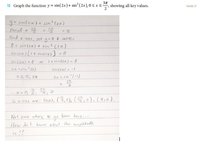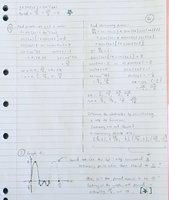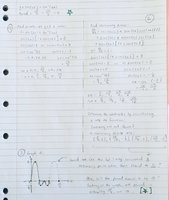You are using an out of date browser. It may not display this or other websites correctly.
You should upgrade or use an alternative browser.
You should upgrade or use an alternative browser.
Applications of Trigonometric Functions (Graphing)
- Thread starter eutas1
- Start date
You have asked questions about calculus so we know you know calculus.
You have identified where f(x) = 0 and f(0).
That is not enough.
Where if anywhere does f’(x) = 0 and what is f’’(x) at those values of x? Where if anywhere does f’’(x) = 0?
How can you use that information to sketch or interpret a graph?
You have identified where f(x) = 0 and f(0).
That is not enough.
Where if anywhere does f’(x) = 0 and what is f’’(x) at those values of x? Where if anywhere does f’’(x) = 0?
How can you use that information to sketch or interpret a graph?
You have asked questions about calculus so we know you know calculus.
You have identified where f(x) = 0 and f(0).
That is not enough.
Where if anywhere does f’(x) = 0 and what is f’’(x) at those values of x? Where if anywhere does f’’(x) = 0?
How can you use that information to sketch or interpret a graph?
But why would you need to consider derivatives??
skeeter
Elite Member
- Joined
- Dec 15, 2005
- Messages
- 3,215
But why would you need to consider derivatives??
increasing ... decreasing ... extrema
concave up ... concave down ... inflection points
ring a bell?
increasing ... decreasing ... extrema
concave up ... concave down ... inflection points
ring a bell?
No, it doesnt.... ?
skeeter
Elite Member
- Joined
- Dec 15, 2005
- Messages
- 3,215
No, it doesnt.... ?
are you taking a formal course in calculus (with a live, breathing instructor)?
If f(x) is a differentiable function on a closed interval, what can you can you say about the values of x where the f(x) will have a local minimum?No, it doesnt.... ?
are you taking a formal course in calculus (with a live, breathing instructor)?
I am in year 12 methods, if that answers your question
If f(x) is a differentiable function on a closed interval, what can you can you say about the values of x where the f(x) will have a local minimum?
OH!!! The maximum/minimum points will be when the derivative is 0!!!! So is that how I find the maximum and minimum points? By finding the derivative function and then setting it equal to 0?
skeeter
Elite Member
- Joined
- Dec 15, 2005
- Messages
- 3,215
OH!!! The maximum/minimum points will be when the derivative is 0!!!! So is that how I find the maximum and minimum points? By finding the derivative function and then setting it equal to 0?
ok ... how does one determine whether there is a maximum or minimum where f’(x) = 0 ?
OK. If I were grading this question on a quiz, I'd give you 50% credit for that answer. (I am an evil grader, which is probably why no one ever encouraged me to teach.) Your answer would be correct if you had saidOH!!! The maximum/minimum points will be when the derivative is 0!!!! So is that how I find the maximum and minimum points? By finding the derivative function and then setting it equal to 0?
"when f(x) has a LOCAL maximum/minimum value in (a, b), the first derivative of f(x) at that value of x will equal 0."
But a value of x where the first derivative of f(x) = 0 may not be a local maximum or minimum. For example
[MATH]f(x) = x^3 \implies f'(x) = 3x^2 \text { and thus } f'(x) = 0 \iff x = 0.[/MATH]
But f(0) is neither a local maximum nor a local minimum in this case because x3 has no local minima or maxima; it is everywhere increasing.
In short, any local extremum of a differentiable function in an open interval entails a first derivative equal to zero.
But it is false that a first derivative equal to zero entails a local extremum.
All biological mothers are biological females, but not all biological females are mothers.
Moreover, we are talking about a closed interval in this problem rather than an open interval. That introduces a complication.
The statement that would get a 100% grade from me would be something like this:
To determine where there may be a local minimum or local minimum of a differentiable function f(x) in the closed interval [a, b], we must look at the values of f(a), f(b), and f(x) for every value of x in (a, b) where f'(x) = 0.
To be very simple, where the first derivative is zero and at the end points of the interval is where we need to TEST for local extrema in a closed interval.
I am sorry to seem so persnickety, but mathematical statements require very close attention to details. They are powerful because they are exact. Every detail is important.
Going back to skeeter's gnomic but very rich post 4, the first and second derivatives will also tell you where the graph is increasing, where it is decreasing, where it is concave up, where it is concave down, and where it has inflection points.
Last edited:
ok ... how does one determine whether there is a maximum or minimum where f’(x) = 0 ?
Your reply had me confused, so I re-attempted the question to see what would happen. I got most of it, however I only calculated 4 out of the 5 stationary points so the last part of my graph is incomplete but I'm not sure how I don't get the 5th stationary point given the domain? Please refer to my attachment!
Attachments
OK. If I were grading this question on a quiz, I'd give you 50% credit for that answer. (I am an evil grader, which is probably why I never taught school.) Your answer would be correct if you had said
"when x has a value in an open interval where f(x) has a LOCAL maximum/minimum value, the first derivative of f(x) at that value of x will equal 0."
But a value of x where the first derivative of f(x) = 0 may not be a local maximum or minimum. For example
[MATH]f(x) = x^3 \implies f'(x) = 3x^2 \text { and thus } f'(x) = 0 \iff x = 0.[/MATH]
But f(0) is neither a local maximum nor a local minimum in this case because x3 has no local minima or maxima; it is everywhere increasing.
In short, any local extremum of a differentiable function in an open interval entails a first derivative equal to zero.
But it is false that a first derivative equal to zero entails a local extremum.
All biological mothers are biological females, but not all biological females are mothers.
Moreover, we are talking about a closed interval in this problem rather than an open interval. That introduces a complication.
The statement that would get a 100% grade from me would be something like this:
To determine where there may be a local minimum or local minimum of a differentiable function f(x) in the closed interval [a, b], we must look at the values of f(a), f(b), and f(x) for every value of x in (a, b) where f'(x) = 0.
To be very simple, where the first derivative is zero and at the end points of the interval is where we need to TEST for local extrema in a closed interval.
I am sorry to seem so persnickety, but mathematical statements require very close attention to details. They are powerful because they are exact. Every detail is important.
Going back to skeeter's gnomic but very rich post 4, the first and second derivatives will also tell you where the graph is increasing, where it is decreasing, where it is concave up, where it is concave down, and where it has inflection points.
Ohno..... I thought I was going fine when I re-attempted the question (comment above) until I read your reply right as I was about to post mine. I am not sure I understand what you are saying.....
We are assuming f(x) is a differentiable function.Ohno..... I thought I was going fine when I re-attempted the question (comment above) until I read your reply right as I was about to post mine. I am not sure I understand what you are saying.....
It is NOT true that at every value of x where f’(x) = 0, f(x) is at a local extremum. I gave you a counter-example with f(x) = x3.
What is true is that at every value of f(x) on an open interval where f(x) is a local maximum or minimum, then f’(x) = 0.
So the way to find local minima or maxima of f(x) an open interval is to find where in that interval f’(x) = 0 and then confirm or reject whether that defines a local extremum.
Do you understand that a entails b does not necessarily mean that b entails a? All beef is meat does not mean that all meat is beef. This is a point that is way broader then mathematics.
Moreover on a closed interval, there can be local extrema where the first derivative does not even exist.
We are discussing basic things here. Where exactly are you getting lost?
We are assuming f(x) is a differentiable function.
It is NOT true that at every value of x where f’(x) = 0, f(x) is at a local extremum. I gave you a counter-example with f(x) = x3.
What is true is that at every value of f(x) on an open interval where f(x) is a local maximum or minimum, then f’(x) = 0.
So the way to find local minima or maxima of f(x) an open interval is to find where in that interval f’(x) = 0 and then confirm or reject whether that defines a local extremum.
Do you understand that a entails b does not necessarily mean that b entails a? All beef is meat does not mean that all meat is beef. This is a point that is way broader then mathematics.
Moreover on a closed interval, there can be local extrema where the first derivative does not even exist.
We are discussing basic things here. Where exactly are you getting lost?
I think I get it - not every value of x where f'(x) = 0 is a local max/min because the end points could be the max/min. Sorry, I just didn't understand your terminology, however, after a quick look back at my year 11 maths book I remember now. I should have phrased my sentence differently - I did mean that it would get the maximum and minimum points for THIS question since it is a sine graph, however I understand that it would not have been correct if it were not a sine graph.
But, how come I only get 4 solutions instead of 5 in my working out?
Steven G
Elite Member
- Joined
- Dec 30, 2014
- Messages
- 14,383
Yes, the end points may be the max or min. The thing is we are NOT looking for the absolute max or the absolute min. The absolute max is the highest point on the curve. Absolute min is the lowest point on the curve.
We want ALL local max/min values.
We want ALL local max/min values.
Yes, the end points may be the max or min. The thing is we are NOT looking for the absolute max or the absolute min. The absolute max is the highest point on the curve. Absolute min is the lowest point on the curve.
We want ALL local max/min values.
I see, that's true. However, I was NOT able to obtain ALL of the max/min values?
Attachments
skeeter
Elite Member
- Joined
- Dec 15, 2005
- Messages
- 3,215
I see, that's true. However, I was NOT able to obtain ALL of the max/min values?
[MATH]0 \le x \le \frac{3\pi}{2} \implies 0 \le 2x \le 3\pi[/MATH]
[MATH]2\cos(2x) = 0[/MATH] at [MATH]x = \frac{\pi}{4}, \frac{3\pi}{4}, \frac{5\pi}{4}[/MATH]
all three are maxima
minima are at [MATH]x = \frac{7\pi}{12}, \frac{11\pi}{12}[/MATH]
[MATH]0 \le x \le \frac{3\pi}{2} \implies 0 \le 2x \le 3\pi[/MATH]
[MATH]2\cos(2x) = 0[/MATH] at [MATH]x = \frac{\pi}{4}, \frac{3\pi}{4}, \frac{5\pi}{4}[/MATH]
all three are maxima
minima are at [MATH]x = \frac{7\pi}{12}, \frac{11\pi}{12}[/MATH]
OH YEAH - I didn't realise 5pi/2 fell into the domain of 2x ...
Thank you!!!!!
[MATH]0 \le x \le \frac{3\pi}{2} \implies 0 \le 2x \le 3\pi[/MATH]
[MATH]2\cos(2x) = 0[/MATH] at [MATH]x = \frac{\pi}{4}, \frac{3\pi}{4}, \frac{5\pi}{4}[/MATH]
all three are maxima
minima are at [MATH]x = \frac{7\pi}{12}, \frac{11\pi}{12}[/MATH]
Oh wait also, isn't the period pi? How come the graph shows a period of 3pi/4 instead of pi?



